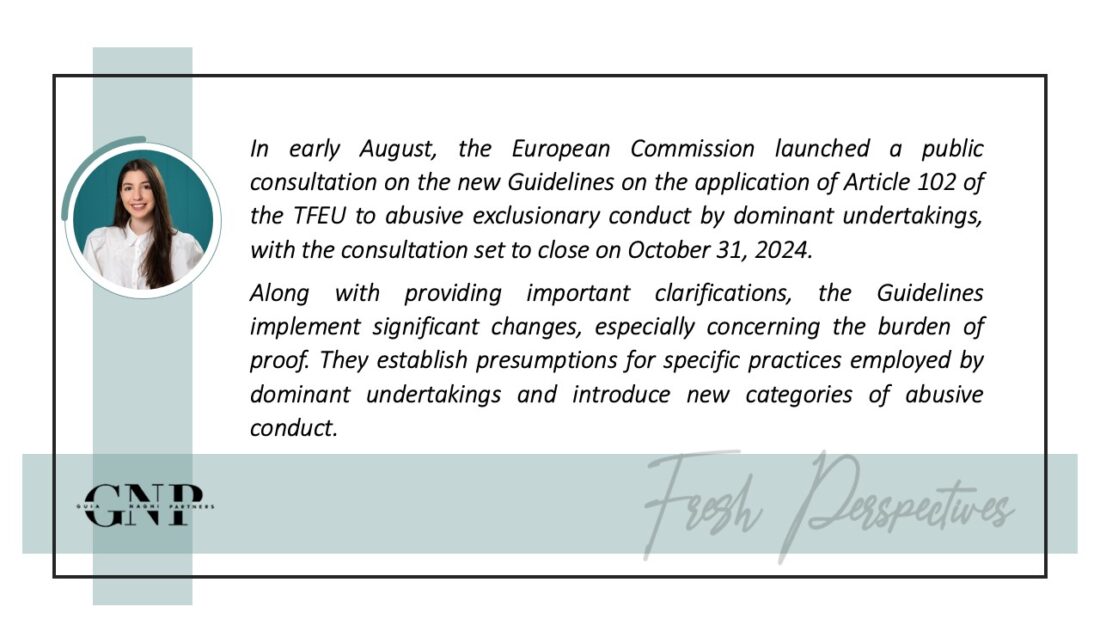Andreea Ivăniș – Draft Guidelines on exclusionary practices – The effect-based approach takes a back-seat
On August 1, 2024, the European Commission launched a public consultation on newly proposed guidelines for the application of Article 102 of the Treaty on the Functioning of the European Union, addressing abusive exclusionary conduct by dominant undertakings (“Draft Guidelines“). These guidelines aim to provide greater clarity on what constitutes abusive behaviour by companies with a dominant market position.
A significant shift in these Draft Guidelines is the move away from the previous approach, which was centred around an economic analysis of abusive practices and direct consumer harm. Instead, the Draft Guidelines introduce a presumption-based approach, representing a key change in how abuse of dominance cases are handled. Under this framework, the burden of proof for certain types of restrictive conduct now shifts from the European Commission to the undertakings accused of abusing their dominant position. This marks a substantial departure from earlier practices, where the Commission bore the primary responsibility for demonstrating such abuse.
Holding a dominant position in the market comes with special responsibilities. While other companies may engage in certain practices with fewer constraints, dominant undertakings must exercise greater caution. This is not to say that dominant firms are prohibited from pursuing their own legitimate business interests, they are free to do so, provided their actions remain reasonable and proportionate.
To strike a fair balance between the responsibilities of dominant companies and their legitimate commercial goals, the Draft Guidelines offer detailed clarifications and outline new approaches, which will be further explored below.
What constitutes abuse?
The Draft Guidelines introduce two cumulative conditions for determining whether the practices of dominant undertakings may constitute exclusionary abuse:
- The undertaking’s practices must move away from merit-based competition
The first condition focuses on whether the practices in question deviate from what is considered merit-based competition. This concept refers to behaviours that align with normal competitive practices based on business performance. In general, merit-based competition benefits consumers by promoting lower prices, enhanced quality, and a broader range of innovative or improved products and services.
For practices that are governed by specific legal tests—such as exclusivity agreements or refusal to supply—as well as practices whose sole purpose is to restrict competition, referred to as “naked restrictions“, the Draft Guidelines establish that these inherently diverge from competition on the merits.
However, for other practices—such as self-preferencing or conditional rebates—the Draft Guidelines provide more practical examples of how these actions may signal a departure from competition on the merits. These examples help clarify when a dominant firm’s behaviour might cross the line into abusive conduct:
- Whether the dominant undertaking restricts consumer choice based on product merits, including quality;
- Whether it provides misleading information or misuses procedures to block competitors;
- Whether it breaks other laws (e.g. data protection) that impact competition parameters like price or quality;
- Whether it engages in biased or discriminatory practices that favour itself over competitors;
- Whether it changes behaviour in an unreasonable or abnormal way, such as unjustifiably ending business relationships;
- Whether an equally efficient competitor could not replicate the conduct due to the dominant firm’s unique resources or position.
- The undertaking’s practices have the capacity to produce exclusionary effects
As a general principle, to establish that a dominant undertaking’s practice has the potential to foreclose competitors from the market, the European Commission must substantiate these exclusionary effects through a concrete analysis supported by evidence. Dominant undertakings will have the opportunity to present counter-evidence to challenge and potentially overturn these findings.
However, for certain categories of conduct—such as naked restrictions or those requiring a specific legal test—the Draft Guidelines allow the European Commission to presume the capability to produce exclusionary effects without the need for a detailed evidentiary analysis. In such cases, the burden shifts to the dominant undertaking to rebut this presumption.
Different categories of practices require different approaches
The Draft Guidelines introduce three categories of restrictions, each subject to a distinct approach by the European Commission when assessing the two cumulative conditions for exclusionary abuse:
- Naked Restrictions
This category involves conduct by dominant undertakings with no economic purpose other than to restrict competition. Such practices are deemed inherently capable of restricting competition. Examples provided in the Draft Guidelines include:
- Payments made by the dominant undertaking to customers, conditional upon delaying or cancelling the launch of competing products;
- Agreements with distributors where competing products are replaced by the dominant undertaking’s product, under the threat of losing rebates;
- Active divestiture of infrastructure used by a competitor.
Given their nature, naked restrictions are presumed to have exclusionary effects, and this presumption can only be rebutted in exceptional circumstances.
- Restrictions requiring a specific legal test
This category encompasses practices for which European law has established a specific legal test. For example, the tying practice’s legal test involves the factual existence of the following: (i) the tying and tied products are distinct; (ii) the undertaking is dominant in the tying product market; (iii) customers are not given the option to purchase the tying product without the tied product; (iv) the tying practice can create exclusionary effects. Once these conditions are met, there is a presumption of exclusionary effects.
Examples of practices in this category include:
- Exclusive dealing;
- Refusal to supply;
- Predatory pricing;
- Margin squeeze;
- Tying and bundling.
These practices are generally presumed to have exclusionary effects, but dominant undertakings can challenge this presumption by presenting evidence, such as economic studies or applying the as-efficient competitor test.
- Other restrictions – no specific legal test required
This third category includes restrictions that do not fall under the first two. The Draft Guidelines identify in this category practices such as:
- Self-preferencing;
- Conditional rebates (other than exclusivity-based rebates);
- Access restrictions;
- Multi-product rebates.
For these types of restrictions, there is no presumption of exclusionary effects, and the burden of proof remains with the European Commission.
Conclusion
In summary, for naked restrictions and those requiring a specific legal test, the two cumulative conditions for determining exclusionary abuse are presumed to be met. While it is extremely difficult to rebut the presumption for naked restrictions, dominant undertakings have more room to challenge the presumption for restrictions subject to specific legal tests, using evidence like economic analysis or the as-efficient competitor test. For other restrictions, however, the burden of proof rests entirely with the European Commission, with no presumption of exclusionary effect.
While these Draft Guidelines are not legally binding on the European Courts, they offer valuable insights into the European Commission’s perspective and interpretative approach regarding the assessment of exclusionary practices by dominant undertakings.





No Comments